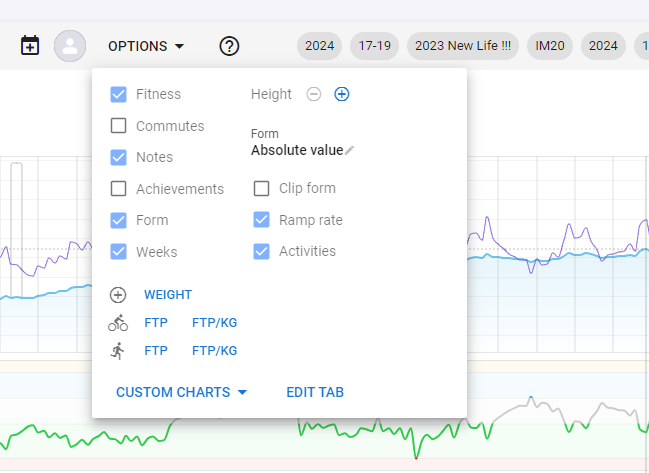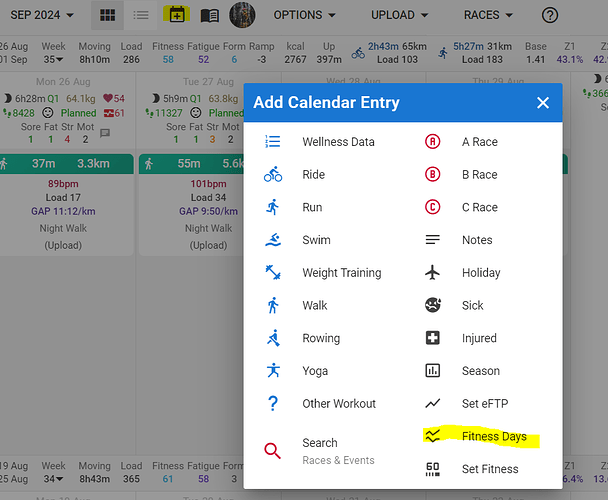Yup, my CTL can remain pretty constant but my STRAVA times can come down especially if I have being doing plenty of LT1 sessions or Steve Neal high torque - low cadence intervals
It takes 6 weeks/42 days of history to fill.
I’ve had a look and it’s interesting.
Comparing TrainingPeaks and Intervals. Rides are similar load, but load for my Core and stretching (I. have 2 bulging discs so do this daily) and Gym work (2xweek) is very different, with TrainingPeaks up to 50% more - not sure why that is. I could potentially adapt this within Intervals by changing the % effect Core work and Strength training have on my fitness
Comparing to XERT where it only records rides. Both are pretty similar on rides where I do hard intervals, but there is quite a difference in my zone 2 rides (majority of my riding). Obvious I suppose, as Intervals will be giving the same load score for a minute at 200w in minute 10 and minute 180. While XERT will give a higher load score for the minute at 180 due it realising that you are getting tired so pushing the same wattage is having a bigger effect on you.
In Intervals, by default, weight training does not contribute to fitness because it has no ‘cardiovascular’ outcome. It’s not like it is not contributing to strength and general health, it just has very little to no effect on your cardiovascular system. If TP counts it fully in your PMC, the best option to get similar results, is to set Weight training to 100% in settings. Keep in mind that this kind of training is calculated from HR, so there could still be considerable differences if the Load from HR calculation is different.
I’m not familiar with XERT’s way of calculating load. But my first impression on what you say, is that they are double counting fatigue since load goes up when riding longer…
The standard way is to count load referencing to FTP per time unit.
Thanks MedTechCD. I’ll look at changing the weight training settings.
XERT is different in that their XSS is a strain score rather than a stress score so calculated differently. I like XERT but it does lack a training plan function which is why I had been using TPeaks.
yup that does it. Now I know why I may change it back and just appreciate that Intervals is more cycling specific when it comes to load. Now no need for TPeaks! Though I would like to see if I can transfer some training plans I have on there over, or maybe it will just have to be the key workouts remade in workout builder
it may have started out as cycling specific, but I do beileve that now it’s getting better at RUn and Swim disciplines.
TP seems like a pain, from what I can find / info from the web, seems like one can’t upload FIT workout files, ERG/MRC workout files and you also can’t download workout files.
Correct me if I’m wrong.
It is working in opposite direction for me: I set ATL days in the past to 9d (instead of default 7d), and the effect on the data is that I recover faster. The Form line moves up. I expected it to move down towards the red area. Has anyone the same problem?
Could someone check this please? I tried to post in the Bug reports sections but apparently I am not allowed to create a new thread.
Fitness days settings is not working as expected. If I increase the number of Fatigue days the Form curve indicates that I recover faster (the whole curve moves up), which is wrong.
Increasing fatigue days increases the weighing applied to past training load vs recent training load. So what it does to form depends on your recent training and it might move up. This is the code:
double atlWeight = Math.exp(-1.0 / r.atl_days);
r.atl = (float)(prev.atl * atlWeight + r.atlLoad * (1.0 - atlWeight));
So for 7 days atlWeight = 0.8668778998. For 9 days it is 0.8948393168.
ATL_today = (ATL_yesterday * atlWeight) + load_today * (1 - atlWeight)
So you can see that increasing fatigue days places a larger weighting on the historical fatigue i.e. recent training load counts less.
why can’t I find this option anymore?

much appreciated
I changed my fatigue days from 7 to 12 (because I’m 61); I chose the first day in my data (back in 2021) to do this on. Most of my curve doesn’t appear to have shifted vertically at all - only horizontally along the time axis. However, the last few days HAVE shifted vertically, and the marathon I ran a week ago goes far less deeply into the red with the fatigue days set to 12 than it does when they are set to 7. Why?
(Let me take the opportunity to say how much I appreciate this app. Great work - it’s the most valuable tool I use, and I use a lot of tools.)
